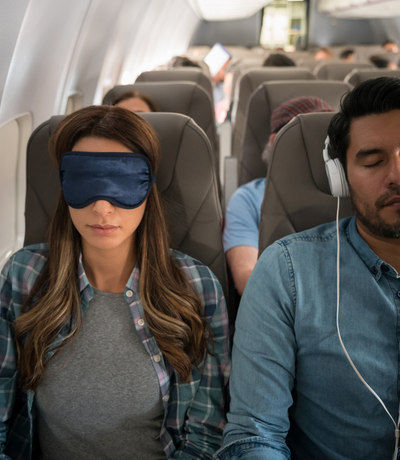Mastering the art and science of sleep when you travel
23 February 2024
You put your body through some serious things when you travel: uncomfortable seats, ear-splitting noise, unpleasant smells. Plus, there’s no airline seat more comfortable and sleep-inducing than a great mattress in a quiet bedroom at home.
Depending on how many time zones you cross, you could be fighting significant jet lag when you arrive―and jet lag is no joke! Some of the most severe symptoms of jet lag can cause real problems.
- Inability to focus or function while awake
- Stomach issues, including diarrhea
- General moodiness and short temper
The Mayo Clinic notes that auto accidents caused by jet-lagged travelers may be more likely. Also, the older you are, the more recovery time you need.
With all you put your body through when you travel, getting quality sleep is critical to your enjoying the trip rather than just surviving it.
Here’s how to get the best quality sleep when you travel.

Keep a consistent routine
The human body craves consistency, and the quicker you can implement your sleep routine at each location, the better you’ll sleep.
- If you hit the sack at 10 at home, do the same when you travel
- If you set the alarm for 6 at home, do the same on your trip
If you stay up late for a show or get up early to meet a tour, aim for a short power nap during the day to catch up, then try to meet your regular routine as soon as possible.
Pack a ‘sleep kit’
Up your sleep game with a complete kit of tools to help you mimic a good sleep environment so you can fall asleep anywhere.
- Not just a light-blocking eye mask – a weighted mask will help stimulate facial pressure points
- Not the typical U-shaped pillow – a breathable neck wrap with support to stop head-bobbing
- Not just ear plugs – noise-cancelling earbuds with your favorite sleepy sounds
- Not just a sweater – a lightweight travel blanket that covers you neck-to-toe on frigid rides
- Not just any cup of tea – a steaming mug of your favorite sleepy-time tea
Frequent travelers also swear by following their normal pre-bed routine of brushing teeth, removing makeup, applying night serum, braiding long hair―anything and everything you do before falling asleep at home, do it when you want to sleep on your trip.
Bonus: Practice using all the items in your sleep kit before your trip so your body is used to them.
Get smart about light
The human body knows to wake up in the morning and feel tired at night partly because of the presence or lack of sunlight. Adversely, the unnatural electronic light of phones, tablets, and computer screens fools the body into thinking it’s daytime and pauses the natural release of your body’s sleep hormone, melatonin.
Melatonin is the body’s way of winding down and preparing for bed and as natural light fades, melatonin steps in to help make you sleepy.
When it’s nearing time for you to go to sleep, shut off or block out sunlight and electronic light and allow your body’s natural functions to pull you toward sleep.
Stay hydrated (but not too much)
Flying is a dehydrating experience―ask any flight attendant! Dehydration increases the effects of jet lag, lowers oxygen levels in your blood, and makes it difficult for your natural sleep rhythm to adjust.
Dehydration can also lead to muscle spasms, headaches, and irritated nasal passages, which can affect your ability to sleep.
Sure, you want to be hydrated enough to sleep and not so hydrated that you have to get up to empty the tank when you’re trying to get some shut-eye.
- Maintain good hydration levels throughout the day when you travel, so you can taper off sipping water before bed.
- Place a water bottle nearby so you can sip if you wake up feeling dry.
Free your toes
If you’re on an extended journey between destinations, try to free your feet. Not only for the sake of comfort but also so you can wiggle your toes. The practice of grounding is based on environmental medicine that has shown surprisingly positive effects on health through direct contact with the earth.
Repeatedly wiggling, clenching your toes, and pressing your feet into the floor (or ground) can have a calming effect. It will increase blood circulation too.
Pro tip: Swap your traveling boots for a pair of warm, cozy socks rather than going barefoot, which can be frowned upon in public spaces.
Related topics
Damian Tysdal is the founder of CoverTrip, and is a licensed agent for travel insurance (MA 1883287). He believes travel insurance should be easier to understand, and started the first travel insurance blog in 2006.
